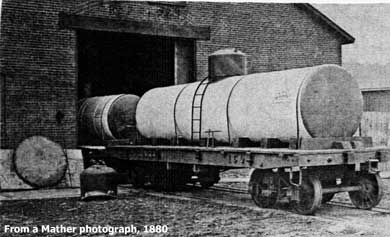 |
||||||
Metal Tank Cars
Inventors suddenly saw ways to improve tank cars and a number of designs appeared, but many of them suffered leaks. Among the first attempts after Densmore was the installation of metal tanks in place of the wooden ones in exactly the same spots on the flat cars. However, the vertical iron tanks created a problem of a different sort, they were tippy. Being top-heavy when full and with the oil sloshing around, especially when the train negotiated curves or underwent sudden stops, the tanks would occasionally tip over and cause a mess as well as occasional fires (Williamson and Daum, 1959). Also, due to space limitation on the cars of that day, the only way to increase the volume was to build them higher and that raised the center of gravity which aggravated the tipping problem. Clearly another design was needed which turned out to be the obvious horizontal boiler tank which, with some modifications is still the basic tank car design on the rails today.
In 1868 the boiler-type tank car was made and tried out. It had the requisite low center of gravity and also had a dome which permitted the oil to expand (a function of temperature) without damaging the sealed horizontal container. The Empire Line, a fast freight subsidiary of the Pennsylvania Railroad, quickly adopted the boiler-type tank car and put it into use in February, 1869 (Giddens, 1938). These horizontal iron tank cars had capacities of 80-90 barrels at first and then 100 barrels during the late 1870’s. The wooden Densmore tank cars gradually disappeared in the 1870’s, as had the wooden oil barrels before them whose days were numbered when pipes began to carry oil in 1865.
 |
A new iron boiler-type tank car coming out of the shops of the Titusville Iron Works. It was made for a part of the Star Tank Line, then a subsidiary of Standard Oil. The name of the line was changed to the Union Tank Car Co. in 1878, but the familiar Star name lingered on for awhile. The initials on the flat bed are OC&A (Oil Creek and Allegheny Railroad), car no. 150. |
![]()
| © 2004, Samuel T. Pees all rights reserved |
|